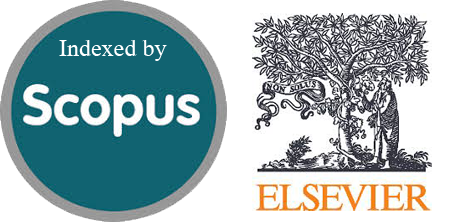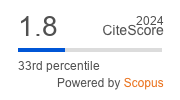Classification of Fruits Based on Shape and Color using Combined Nearest Mean Classifiers
Abstract
Fruit classification is an important task in many agriculture industry. The fruit classification system can be used to identify the types and prices of fruit. Manual classification of fruit is not efficient for large amount of fruits. The advancement of information technology has made possible fruit classification be done by a machine. This research aims to propose a fruit classification methodology based on shape and color. To reduce the effect of lighting variability a color normalization is carried out prior to feature extraction. The color features used in this research are mean and standard deviation. The shape features are area, perimeter, and compactness. The classification of an unknown fruit is carried out using the nearest mean classifier. The method developed in this research is tested using 12 classes of fruits where each class is represented by a number of samples. The experimental results show that the method proposed in this research provides an accuracy of 95.83% for two samples per class and 100% for three samples per class. Experiment on small training samples has been conducted to evaluate the performance of the proposed combined nearest mean classifiers and results obtained showed that the technique was able to provide good accuracy.
Downloads
References
H. A. Hambali, S. L. S. Abdullah, N. Jamil, and H. Harun, “Fruit classification using neural network model,” J. Telecommun. Electron. Comput. Eng., vol. 9, no. 1–2, pp. 43–46, 2017.
O. Sagi and L. Rokach, “Ensemble learning: A survey,” Wiley Interdisciplinary Reviews: Data Mining and Knowledge Discovery, vol. 8, no. 4. 2018, doi: 10.1002/widm.1249.
M. Astani, M. Hasheminejad, and M. Vaghefi, “A diverse ensemble classifier for tomato disease recognition,” Comput. Electron. Agric., vol. 198, p. 107054, 2022, doi: https://doi.org/10.1016/j.compag.2022.107054.
J. Kang and J. Gwak, “Ensemble of multi-task deep convolutional neural networks using transfer learning for fruit freshness classification,” Multimed. Tools Appl., vol. 81, Jul. 2022, doi: 10.1007/s11042-021-11282-4.
H. S. Gill, O. I. Khalaf, Y. Alotaibi, S. Alghamdi, and F. Alassery, “Fruit Image Classification Using Deep Learning,” Comput. Mater. Contin., vol. 71, no. 2, pp. 5135–5150, 2022, doi: 10.32604/cmc.2022.022809.
C. C. Ukwuoma, Q. Zhiguang, M. B. Bin Heyat, L. Ali, Z. Almaspoor, and H. N. Monday, “Recent Advancements in Fruit Detection and Classification Using Deep Learning Techniques,” Math. Probl. Eng., vol. 2022, p. 9210947, 2022, doi: 10.1155/2022/9210947.
P. Sumari et al., “A Precision Agricultural Application: Manggis Fruit Classification Using Hybrid Deep Learning,” Rev. d’Intelligence Artif., vol. 35, no. 5, pp. 375–381, 2021, doi: 10.18280/ria.350503.
Z. Mai, R. Li, H. Kim, and S. Sanner, “Supervised Contrastive Replay: Revisiting the Nearest Class Mean Classifier in Online Class-Incremental Continual Learning,” CoRR, vol. abs/2103.13885, 2021, [Online]. Available: https://arxiv.org/abs/2103.13885.
E. Santucci, “Quantum Minimum Distance Classifier,” Entropy, vol. 19, no. 659, pp. 1–14, 2017, doi: 10.3390/e19120659.
P. C. Sen, M. Hajra, and M. Ghosh, “Supervised Classification Algorithms in Machine Learning: A Survey and Review BT - Emerging Technology in Modelling and Graphics,” 2020, pp. 99–111.
K. D. Copsey, Statistical Pattern Recognition. Wiley, 2011.
I. H. Sarker, “Machine Learning: Algorithms, Real-World Applications and Research Directions,” SN Comput. Sci., vol. 2, no. 3, pp. 1–21, 2021, doi: 10.1007/s42979-021-00592-x.
X. Yan and L. Gao, “A feature extraction and classification algorithm based on improved sparse auto-encoder for round steel surface defects,” Math. Biosci. Eng., vol. 17, no. 5, pp. 5369–5394, 2020, doi: 10.3934/MBE.2020290.
I. Reppa, K. E. Williams, W. J. Greville, and J. Saunders, “The relative contribution of shape and colour to object memory,” Mem. Cognit., vol. 48, no. 8, pp. 1504–1521, 2020, doi: 10.3758/s13421-020-01058-w.
M. H. Guo et al., “Attention mechanisms in computer vision: A survey,” Comput. Vis. Media, vol. 8, no. 3, pp. 331–368, 2022, doi: 10.1007/s41095-022-0271-y.
M. Han, H. Wu, Z. Chen, M. Li, and X. Zhang, “A survey of multi-label classification based on supervised and semi-supervised learning,” Int. J. Mach. Learn. Cybern., 2022, doi: 10.1007/s13042-022-01658-9.
K. . Kendall and J. . Kendall, System Analysis and Design, 8th ed. New Jersey: Prentice-Hall, 2020.
V. Meshram, K. Patil, V. Meshram, D. Hanchate, and S. D. Ramkteke, “Machine learning in agriculture domain: A state-of-art survey,” Artif. Intell. Life Sci., vol. 1, no. September, pp. 1–11, 2021, doi: 10.1016/j.ailsci.2021.100010.
D. N. Arulnathan, B. C. W. Koay, W. K. Lai, T. K. Ong, and L. L. Lim, “Background Subtraction for Accurate Palm Oil Fruitlet Ripeness Detection,” in 2022 IEEE International Conference on Automatic Control and Intelligent Systems (I2CACIS), 2022, pp. 48–53, doi: 10.1109/I2CACIS54679.2022.9815275.
N. Phuangsaijai, J. Jakmunee, and S. Kittiwachana, “Investigation into the predictive performance of colorimetric sensor strips using RGB, CMYK, HSV, and CIELAB coupled with various data preprocessing methods: a case study on an analysis of water quality parameters,” J. Anal. Sci. Technol., vol. 12, no. 1, 2021, doi: 10.1186/s40543-021-00271-9.
T. Gevers and A. Smeulders, “Foreword,” Lect. Notes Comput. Sci. (including Subser. Lect. Notes Artif. Intell. Lect. Notes Bioinformatics), vol. 9909 LNCS, p. V, 2016, doi: 10.1007/978-3-319-46493-0.
N. Ali, D. Neagu, and P. Trundle, “Evaluation of k-nearest neighbour classifier performance for heterogeneous data sets,” SN Appl. Sci., vol. 1, no. 12, pp. 1–15, 2019, doi: 10.1007/s42452-019-1356-9.
K. Taunk, S. De, S. Verma, and A. Swetapadma, “A Brief Review of Nearest Neighbor Algorithm for Learning and Classification,” in 2019 International Conference on Intelligent Computing and Control Systems (ICCS), 2019, pp. 1255–1260, doi: 10.1109/ICCS45141.2019.9065747.
S. Johri et al., “Nearest centroid classification on a trapped ion quantum computer,” npj Quantum Inf., vol. 7, no. 1, 2021, doi: 10.1038/s41534-021-00456-5.
Y. A. Malkov, “Efficient and robust approximate nearest neighbor search using Hierarchical Navigable Small World graphs,” IEEE Trans. Pattern Anal. Mach. Intell., pp. 31–33, 2018, [Online]. Available: https://github.com/nmslib/nmslib%0Ahttp://ann-benchmarks.com/hnsw(nmslib).html.
R. C. Chen, C. Dewi, S. W. Huang, and R. E. Caraka, “Selecting critical features for data classification based on machine learning methods,” J. Big Data, vol. 7, no. 52, 2020, doi: 10.1186/s40537-020-00327-4.
J. Lv and J. Fang, “A Color Distance Model Based on Visual Recognition,” Math. Probl. Eng., vol. 2018, 2018, doi: 10.1155/2018/4652526.
R. Manisha, “Content Based Image Retrieval using Color and Texture Feature with Distance Matrices,” Int. J. Sci. Res. Publ., vol. 7, no. 8, pp. 512–523, 2012, doi: 10.5121/sipij.2012.3104.
Copyright (c) 2023 Jurnal RESTI (Rekayasa Sistem dan Teknologi Informasi)

This work is licensed under a Creative Commons Attribution 4.0 International License.
Copyright in each article belongs to the author
- The author acknowledges that the RESTI Journal (System Engineering and Information Technology) is the first publisher to publish with a license Creative Commons Attribution 4.0 International License.
- Authors can enter writing separately, arrange the non-exclusive distribution of manuscripts that have been published in this journal into other versions (eg sent to the author's institutional repository, publication in a book, etc.), by acknowledging that the manuscript has been published for the first time in the RESTI (Rekayasa Sistem dan Teknologi Informasi) journal ;








